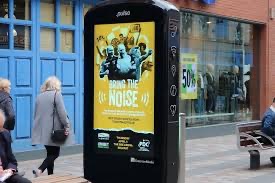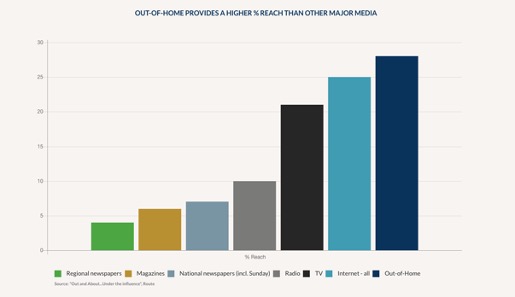First off what actually is it? Put simply, out of home (OOH) advertising is any form of advertising you see in public places and therefore ‘out of your home.’ Examples of this can be found in train stations, grocery stores, on bus shelters etc.
Living in a fast-paced, diverse and continuously evolving digital era means that we can sometimes become blindsided to the benefits that traditional OOH advertising can offer. Some may feel that OOH is dying in an age of digital media and online campaigns. Some may believe that with such a focus on social media and with the population spending more time on their phones and less time focused on the outside environment that it can be a waste of time and resources. However, for me this is not the case.
Every week 98% of the population see some kind of OOH advertising in the UK. It has the potential to reach commuters, students, business people, busy parents, shoppers and the list goes on. Basically, it can reach everyone. Therefore, throughout this blog I will provide five compelling reasons as to why OOH advertising is so valuable and not ‘old-fashioned’.

The present and most definitely the future of OOH advertising is digital. As technology evolves and becomes smarter and more sophisticated OOH mediums will too. Digital out of home (DOOH) advertising will help create more ways to engage and share messages with potential prospects. DOOH is able to build upon the traditional advertising mediums with the added digital benefits of flexibility and addressability. This will to help to create a more powerful, advanced and influential industry helping to inspire prospects and therefore aid goal achievement for brands.

1. It Reaches People
As I said before, it doesn’t matter if you’re walking your dog, driving to work or going out to the shops you are exposed to a huge variety of physical media formats. These formats cannot be blocked, skipped or deleted but are noticed by people every day in the real world. They provide the perfect opportunity to achieve a mass reach within your market on a regular basis at a rapid rate. It’s thought that on average we spend 3 hours 10 minutes in public places each day. This means that there’s a huge opportunity for brands to provide multiple highly targeted messages in the right context. This will therefore, aid audience engagement as people go about their daily lives and will consequently influence their purchasing decisions in the future. As we see population, traffic and urbanisation increase so does the prospect to communicate with audiences via OOH advertising.

2. OOH Drives Online Engagement
Majority of those who are viewing billboards (traditional / digital), adshels or transit advertising for example tend to be young, urban and affluent consumers. According to Route the “urban clustering” of digital screens means that 37% of all DOOH are seen by 15-34-year-olds and 63% by ABC1s. These individuals are constantly on the move, highly social and most importantly digitally connected. This means that these cohorts of the population are more likely to share and engage with an advertisement via word-of-mouth and social media. They are also more likely to complete a mobile search after seeing an OOH advert compared to any other type of media.
OOH / DOOH advertising works naturally with mobile and both are complementary of each other. Utilising both mediums intentionally together means that message frequency is higher. This can result in greater engagement, click-through-rates and therefore campaign success.

3. OOH Media Formats are Highly Targeted
The key to an effective outdoor media campaign is DATA! This means knowing where your audience is and understand their behaviours. Digital out-of-home media formats enables brands to take advantage of this by strategically selecting specific locations that would reach their desired audience most effectively.
The use of geolocation data for example allows brands to create a ‘roadmap’ of the top sites to buy and the best times to run their targeted ads to reach the right audience at the right time in the right place.
DOOH ad campaigns can have heightened relevance and customisation through the use of dynamic creation optimisation (DCO). This means various digital media formats can make use of the time of day, traffic, weather and temperature to engage with your audience during certain moments of their day. In short, DOOH can enable a wide reach with a narrow focus.
4. Always On
OOH advertising mediums are on display 24 hours a day. They can be viewed at any time… whether it’s first thing in the morning or last thing at night they are always on display, waiting to grab people’s attention. They have no switch off time. Outdoor advertising cannot be missed as Clear Channel states, “it’s always on, always being seen.” This leads nicely to my final point…
5. It’s cost-effective
If you know you want / need to raise awareness of your brand however, you are concerned about your budget… OOH is the perfect cost-effective platform. Depending on the audience you wish to reach and your objectives you can decide to advertise on one adshel or 500 billboards… The power really is in your hands.
As described earlier OOH media formats can reach a huge national audience at a rather reasonable price. When you combine the mass reach with scalability and the cost per thousand impressions (CPM) it is evident that OOH is an extremely cost-effective option.
Moreover, deciding to advertise using digital out-of-home media formats can be even more cost effective. Unlike traditional OOH media formats printing, installation and maintenance expenses are eliminated. This means there are no printing, manual labour or recurring costs. DOOH media formats be can installed rapidly with only the cost of screens and setup required.
Overall, brands are likely to have a greater return on investment (ROI) with their advertising campaign using OOH media formats while ensuring maximum engagement.

Hopefully, I have managed to convince you that out-of-home advertising is not dying in this digital era. It is only evolving and becoming more dynamic to adapt to the diverse and rapidly changing digital world that we live in. It’s obvious that digitisation is not here to replace traditional advertising. Instead, it provides an opportunity for the two mediums to work together and complement each other in order to adapt to and meet the expectations of consumers. The past performance of traditional OOH advertising highlights how influential OOH can be. Today, various locations, formats, data and technology provides an exciting possibility to make a meaningful difference for brands.
Alice Byrne is a second year BSc in Communication, Advertising & Marketing student at Ulster University. She can be found at – Linkedin: Alice Byrne and Twitter: @alice_byrne